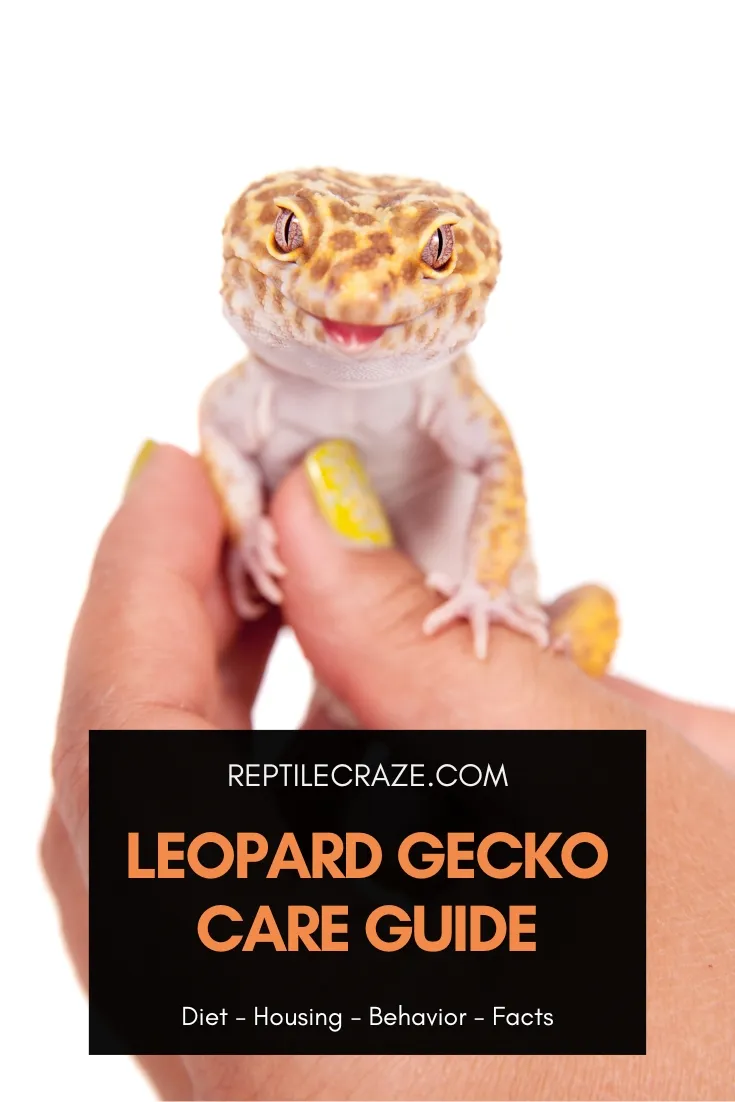
Leopard geckos are known for being quite easy to care for and therefore, many people get their kids a leopard gecko as a first reptile. However, there is more to proper leopard gecko care than just throwing a hide and a reptile carpet in a
This care guide will show you everything you need to know.
Table of Contents
Leopard Gecko Facts
| Common Name: Leopard Gecko Scientific Name: Eublepharis macularius Natural Habitat: Arid, mountainous deserts, and semi-deserts of the Middle East and Asia Adult Size: 8”–10”, including the tail Enclosure Size: At least 36″ x 18″ x 18″ for one adult leopard gecko Diet: Insects Lifespan: 20 years Experience Level: Beginner |
Where Do Leopard Geckos Live?
Leopard geckos’ natural habitat is the arid and semi-desert parts of Afghanistan, Iran, Iraq, northwestern India, Pakistan, and western Nepal.
These desert-dwellers’ rocky and dry habitat has sparse vegetation and clay or sandy soils. When leopard geckos live in rocky areas, they use crevices as shelter.
In the arid forests of Nepal and Pakistan, however, the leopard geckos use loose tree bark as shelter.
Leopard Gecko Appearance
Most leopard geckos are a combination of yellow, black, and white – their backs are light to dark yellow with black markings while their chest and abdomen are white.
The top half of their faces are the same yellow color as their backs – also with black markings – while the bottom half is white. Due to selective breeding, some leopard geckos have bright orange or even lilac coloring.
Leopard geckos’ tails, which are quite plump in relation to their body and serve as a fat reserve, are banded. Unlike many geckos, leopard geckos have eyelids.
They can’t, however, climb on vertical surfaces as they lack the toe pads that most geckos have.
Leopard Gecko Colors And Morphs
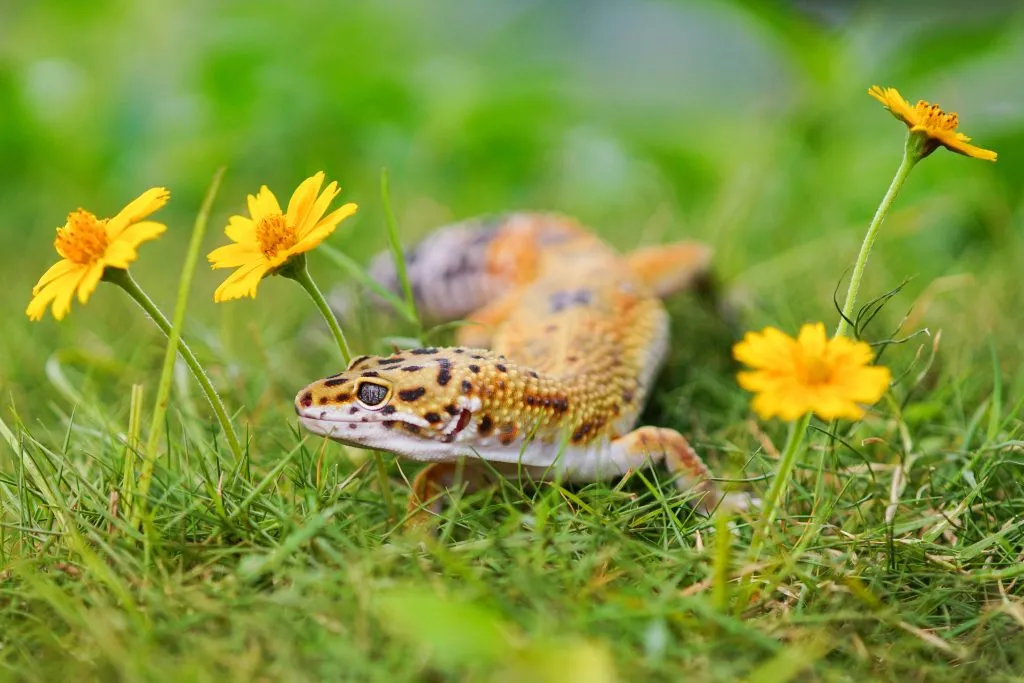
Leopard geckos show variations in color and patterning (and sometimes even in certain physical features’ size or shape) due to spontaneous mutations or selective breeding.
The prices of these “morphs” as they are called, differ from type to type as some are much rarer than others.
For example, rare morphs like the all-black Black Night can cost over $3,000 while “normal” or naturally colored leopard geckos may cost only $25.
There are six main types of leopard gecko morphs:
| Albinos | Are lighter and lacking in color because of the absence of the tyrosinase enzyme. |
| Blizzards | Display solid colors and are patternless. |
| Eye morphs | Bred to have eyes with a different shape or eye color. |
| Giants | Bred to be up to 2” larger than the average leopard gecko. They can weigh some 100g. |
| Melanistics | Either lighter or darker (hypo melanistic or hyper melanistic) than the average “normal” or “naturally colored” leopard gecko. |
| Striped morphs | Bred to have different types of stripes running along their backs. |
Differences Between Male And Female Leopard Geckos
Female leopard geckos are smaller than their male counterparts, usually measuring 7.1 to 7.9 inches in length, making them approximately one inch, or 2.5 cm, shorter than males on average.
The male and female coloring are similar and it’s only through sexing that the sex of the leopard gecko can be detected.
The sex of a leopard gecko can be discovered from the age of four months by checking their preanal pores and for a hemipenal bulge.
Male leopard geckos have a V-shaped row of enlarged preanal pores, quite visible to the naked eye, as well as a hemipenal bulge at the base of their tails, cranial to the vent.
A female’s preanal pores are difficult to detect and she won’t have a hemipenal bulge at the base of her tail.
Wanna find out if you leopard gecko is a boy or a girl? We show you how to do that here!
How Big Do Leopard Geckos Get?
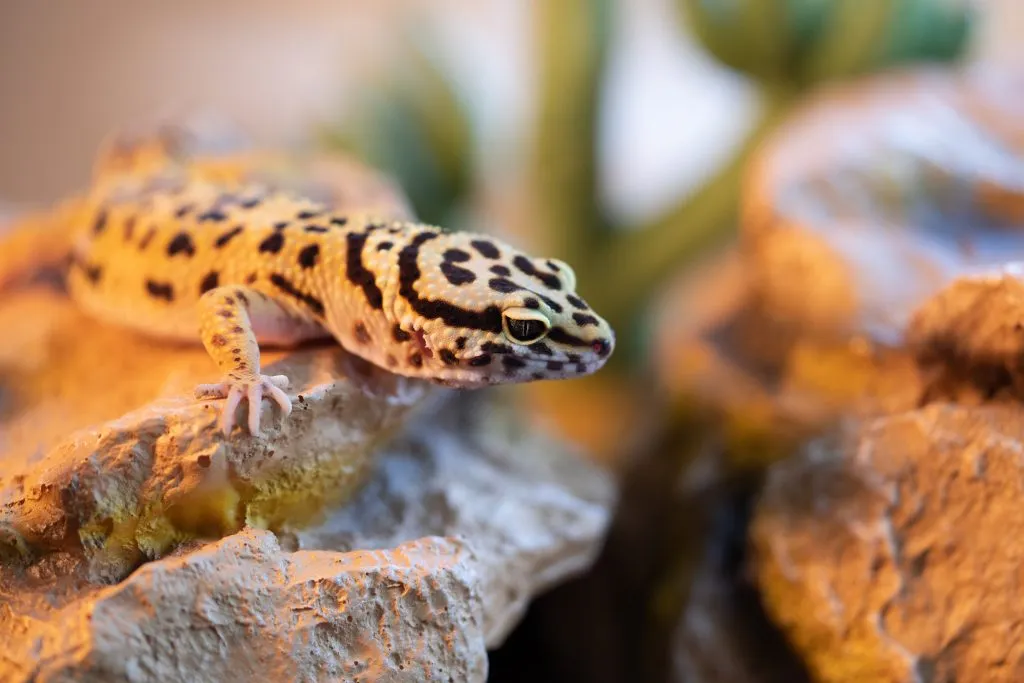
Adult leopard geckos are on average 8” in length and weigh an average of 45-60g according to VetFolio. The largest leopard gecko morphs can reach 10” or longer in length and weigh some 100g.
It’s good to keep in mind that leopard geckos grow really fast, so if you’re planning on using a smaller
Hatchlings are only 3-4” long and weigh 2-5g, but at one month they’ve increased their weight to 15-20g. By six months they are 5-6” in length and weigh 25-60g.
By 18-24 months leopard geckos are fully grown at 8-10” and weigh 40-80g.
Leopard Gecko Lifespan
According to PetMD and other reputable sources, leopard geckos tend to live for 6-8 years in the wild. However, as well-cared-for pets, leopard geckos live for 10-20 years.
The oldest pet leopard gecko on record was 28 years old! Male leopard geckos usually live longer than female leopard geckos, especially if the females are used for breeding.
How To Care For Leopard Geckos
Although it’s easy to care for leopard geckos, they do have some specific needs to stay healthy and happy.
In this part of the care sheet, we’ll go over how to set up a leopard gecko
Leopard Gecko Tank Setup
Setting up your leopard gecko’s
Tank Size
Most people use a 20-Gallon
A
Because leos aren’t climbers like many other gecko species, the
Some of the tanks to consider for your leopard gecko, are the WACOOL 40-gallon tank or if you want to give your leo some extra space, this 36”-wide, 60-gallon tank by Repti Zoo.
A 20-gallon
Lighting And Temperature
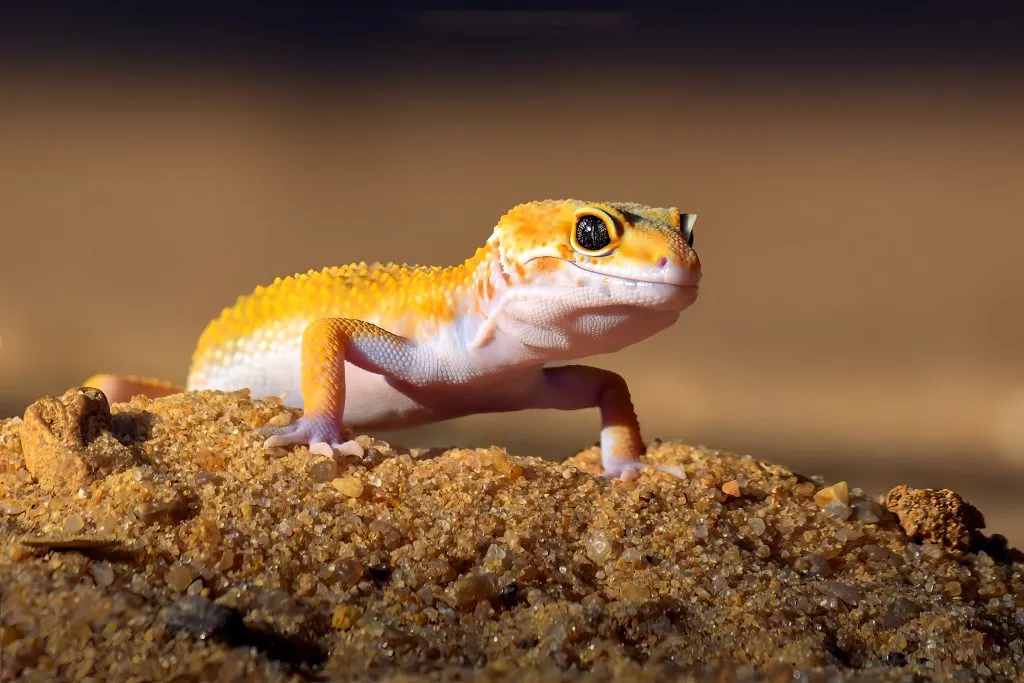
The lighting and temperature throughout your leopard gecko’s
Because leos are cold-blooded, they need an external heat source to get the correct body temperature. In the wild, leopard geckos can bask in the sun, but in a
Never put your leopard gecko’s
You furthermore need to create a temperature gradient in the
| Tank Temperatures For Leopard Geckos | ||
| Part Of | Degrees In Fahrenheit | Degrees In Celsius |
| Basking Spot | 94 – 97 | 34 – 36 |
| Warmest Part Of | 90 – 92 | 32 – 33 |
| Coolest Part Of | 70 – 77 | 21 – 25 |
| Nighttime Temperature | No lower than 60°F or 16°C. |
To create the basking spot and heat the
The best light bulbs to use for leopard gecko tanks are Fluker’s Basking Spotlight Bulbs for Reptiles and the LUCKY HERP Reptile Heat Lamp.
Do Leopard Geckos Need UVB?
Yes, leopard geckos do need some UVB as it’s used to synthesize vitamin D and helps with calcium metabolism. The light bulb you use in your leo’s
For example, those morphs that are very dark or contain a lot of deep colors, need a higher UV index (UVI) of 0.5 to 1.5 according to the article by Frances Baines, and will need a stronger light like the Zoo Med Reptisun 10.0.
Albino leopard gecko morphs or morphs with less pigmentation need a low UVI of 0.5 to 0.7 and you’ll, therefore, need to use a weaker bulb like the Zoo Med Reptisun 5.0. Black or red nighttime lights aren’t necessary.
Which Substrate To Use For Leopard Geckos
There are a variety of substrates available that can be used for leopard geckos.
Although something like reptile carpet, tiles, or newsprint can be used in a quarantine
For the permanent substrate, you can use natural soils which have been prepared for use with leopard geckos.
The natural substrates that you can use for your leopard gecko include Exo Terra Desert Sand combined with Eco Earth and – especially if you’re planning a bio-active
Humidity
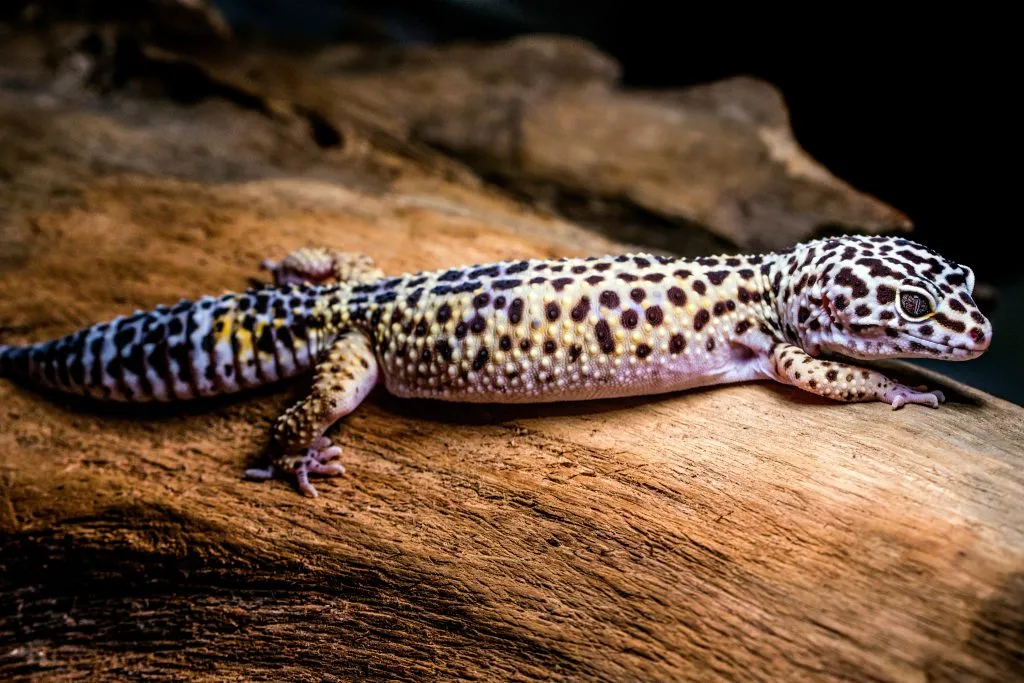
Because leopard geckos’ natural habitat is mostly arid, the ideal humidity for them is quite low at between 30% and 40%. Use a hygrometer in your leo’s
Too high humidity can lead to your leo getting sick.
Leopard Gecko Tank Decor
Along with the substrate and
Tip: Read our article on the best plants for leopard gecko tanks here!
Although you can go ahead and use some real plants in your leopard gecko’s
Hides and wood to climb on (like these) are great for your leo to climb about on, as well as for anchoring smaller succulent plants. For hides, you can look at something like the Zilla Bark Bends.
How To Clean A Leopard Gecko Tank
Cleaning your leopard gecko’s
- Every day:
- Remove any feces and uneaten pieces of
food - Wash
food and water bowls
- Remove any feces and uneaten pieces of
- Every week:
- Remove and dispose of any soiled substrate
- Remove and clean the plants if they’re fake, otherwise mist and wipe them
- Wash
food and water bowls
- Every month:
- Change the substrate (unless it’s a bioactive
tank !) - Wash all the faux plants thoroughly, along with the hides, bowls, etc.
- Wash the
tank itself with a safe cleaning solution, like Fluker’s Super Scrub Brush with Organic Cleaner. - After everything is clean and dry, pour in the fresh substrate and replace the decor.
- Change the substrate (unless it’s a bioactive
Leopard Gecko Diet
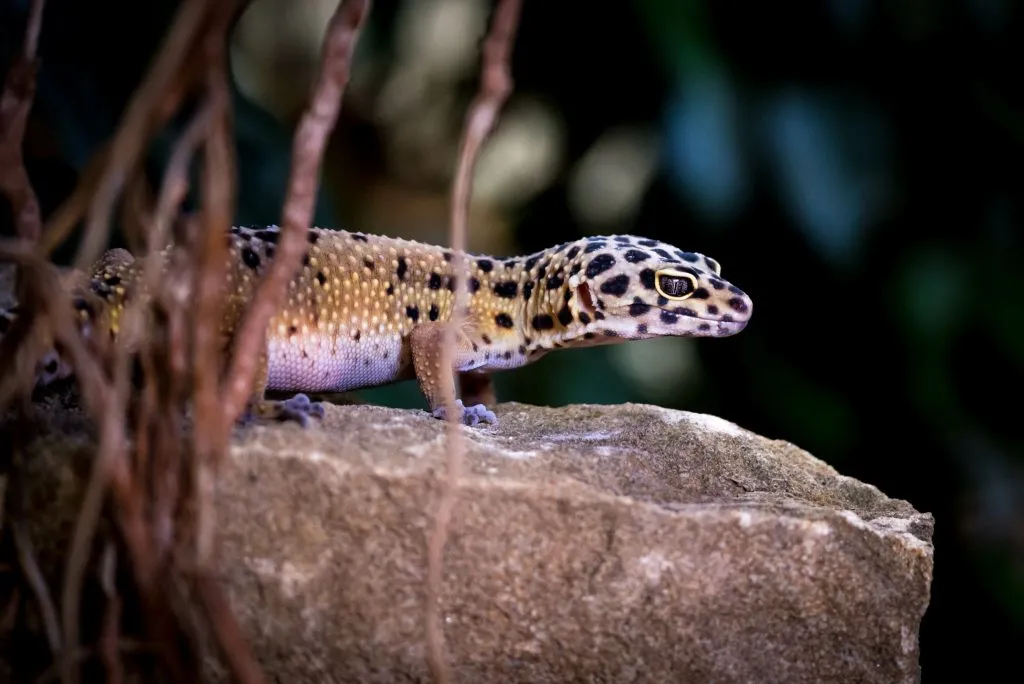
What To Feed Leopard Geckos
Leopard geckos are insectivores, meaning that they only eat insects and, unlike some reptiles, should not be fed plants as well.
All insects should be gutloaded before being fed to your leopard gecko in order to ensure that they get all the necessary nutrition from the insects.
Insects you can feed your leopard gecko, are (gutloaded):
- Crickets
- Dubia roaches
- Black soldier fly larvae
- Buffalo worms
- Silkworms
Larger leopard geckos can also eat superworms. Butterworms, hornworms, and waxworms must only be given as an occasional treat.
To gutload insects, feed them a rich variety of fresh vegetables and plant matter approximately 24-48 hours before feeding your leopard gecko.
Be sure to dust some of the insects every week with calcium powder to ensure that your leo gets all the calcium they need and doesn’t get sick.
Tip: Read our leopard gecko diet guide to learn everything on feeding them correctly.
How Often You Should Feed Leopard Geckos
Leopard geckos should be fed according to their age, size, and the amount that they’ve eaten in their previous meal.
For example, if you’ve given your leo a butterworm treat, they may skip a meal and this is nothing to worry about.
| Leopard Gecko Feeding Schedule | ||
| Growth Stage | Age | Frequency Of Feeding |
| Baby | 0-4 months | Every day |
| Juvenile | 4-6 months | Begin to skip days until they only eat every other day |
| Sub-Adult | 6-12 months | Every other day |
| Adult | 12 months and older | Every 2-3 days |
How Long Leopard Geckos Can Go Without Food
The length of time that leopard geckos can go without food depends on their age and health. A healthy leo can go for longer without
| How Long Leopard Geckos Can Go Without | ||
| Age | Size | Length Of Time Without |
| Hatchling | 3”-4” | Don’t leave without |
| 1 Month | 4” | No longer than 1 day |
| 2 Months | 5” | No longer than 2 days |
| 6 Months | 5”-6” | 2-7 days |
| 12 Months | 7”-10” | 14 days – 1 month |
| 18 Months + | 7”-10” | Over 1 month |
Do Leopard Geckos Need Water?
Yes, leopard geckos must always have access to clean, fresh water. Make sure to wash the water bowl every day when changing the water.
The Vitamins And Minerals Your Leopard Gecko Needs To Stay Healthy
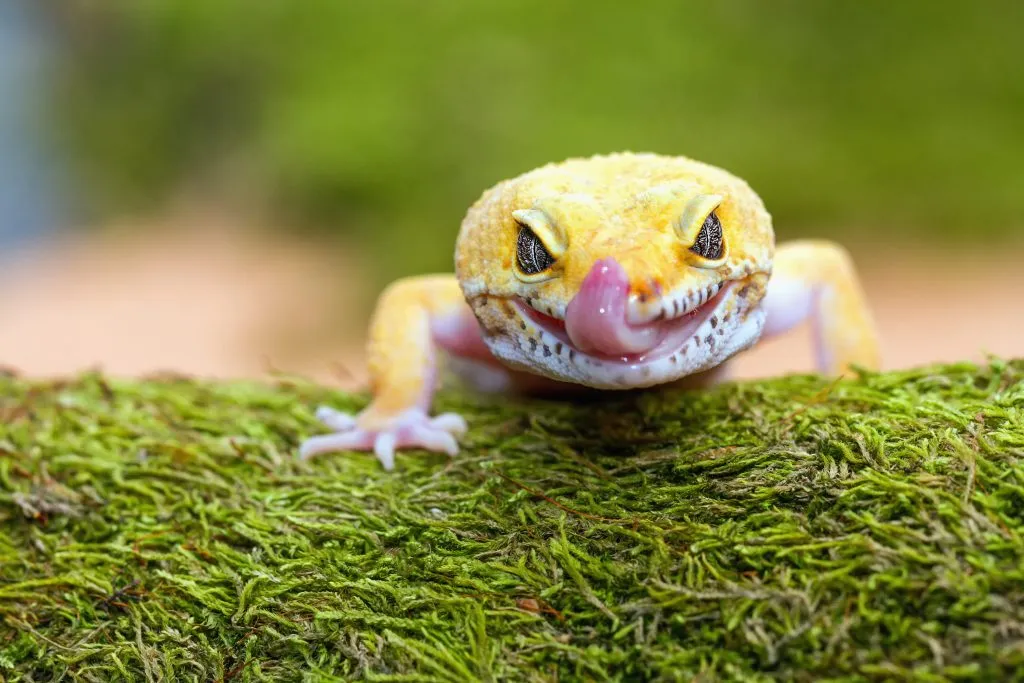
If you gutload your feeder insects properly and dust them with calcium powder as described above, you shouldn’t have to supplement their diet any further except if told to do so by a vet.
Tip: We created a vitamin schedule for leopard geckos here!
Leopard Gecko Behavior and Temperament
Leopard geckos are considered a beginner’s reptile, not only because of how easy it is to look after them but also because of their behavior and temperament.
| Leopard Gecko Behavior And Temperament | |
| Friendliness | Leopard geckos are, on average, friendly once they get to know you. This is why it’s important to spend time with your leo and to bond with them early on. |
| Do They Bite? | Sometimes leopard geckos can bite. This may be out of fright, irritation, or even by accident if you’re trying to feed them by hand. The bite, however, is not severe or very painful. |
| Aggressiveness | Most leopard geckos aren’t aggressive, although they have to be respected. If they want to be left alone and they’re not, expect some aggressiveness, for example. They are also aggressive towards other leopard geckos and should, therefore, be kept alone in a |
| Are They Venomous? | No, leopard geckos aren’t venomous. However, you should still wash your hands thoroughly after handling them. |
Are Leopard Geckos Good Pets?
Leopard geckos are good pets, but you should respect that they are still reptiles and will not be tame like a dog or cat and don’t show affection in the same ways as mammals might.
You should also buy your leopard gecko from a respected breeder and not from the wild.
Tip: We listed the pros and cons of keeping leopard geckos as pets here.
How To Handle Leopard Geckos
Leopard geckos should be handled carefully and their bodies should always be supported when they are picked up or held. These geckos can lose their tails and should, therefore, not be picked up by their tails.
Leopard Geckos’ Common Health Problems
The most common health problems for leopard geckos are:
- Dysecdesis
- Egg binding
- Hemipene infections
- Metabolic Bone Disease (MBD)
- Parasites (Helminths and Cryptosporidia)
These all need veterinary intervention of some kind, but can mostly be prevented through good husbandry.
Where To Buy Leopard Geckos
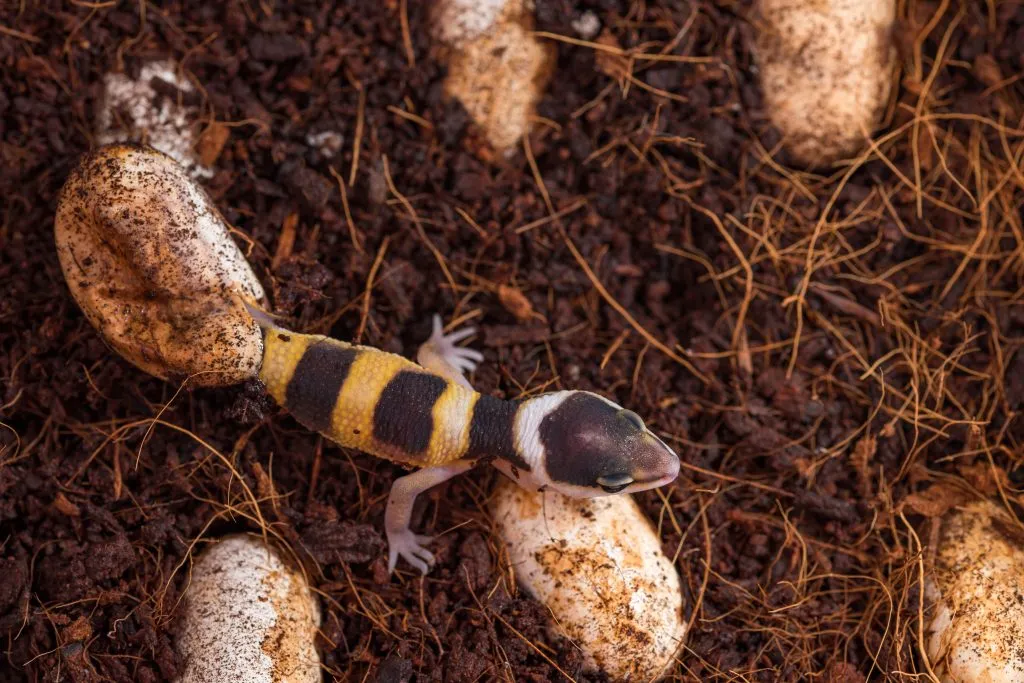
Leopard geckos can often be bought at pet shops, but make sure that they get their leos from reputable breeders.
The best way, however, is to go directly to a leopard gecko breeder and buy from them. The leo’s health, age, etc. can then be verified.
3 Great US Leopard Gecko Breeders
CB Reptile – CB Reptile has the widest range of leopard gecko morphs in the USA and has a biologist on-site to ensure gene quality. A top breeder that’s been trusted for years.
BHB Reptiles – BHB Reptiles is another big name in the leopard gecko world and has a huge range of leo morphs to choose from.
Decked Out Geckos – Evan Wooldridge from Decked Out Geckos specializes in unique leopard gecko morphs.
How Much Do Leopard Geckos Cost?
Leopard geckos can cost anywhere from $25 to over $3,000 depending on the morph that you buy. The most expensive morphs, like the Black Night, will set you back a couple of grand, while others may only be a hundred or two hundred.
Leopard Gecko Breeding
Breeding with leopard geckos is fairly easy but is not recommended to beginners, as it’s difficult to keep the eggs and hatchlings alive and there is always the chance of egg-binding or other complications that could cost your leo their life.
Conclusion
If you’re looking for a reptile to start with, look no further than these both cute and beautiful geckos. There are a wide variety of morphs to choose from and looking after leos is relatively easy, making them ideal for beginners.
- Eastern Rat Snake: Nature’s Pest Control and Fascinating Reptile - September 20, 2024
- Eastern Racer: The Fast and Agile Snake - September 19, 2024
- The Eastern Indigo Snake: The Majestic, Non-Venomous Hunter of the Southeast - September 18, 2024
